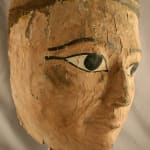Ptolemaic Painted Wooden Funerary Mask, 3 Century BCE - 1st Century BCE
Painted Wood
10.25 x 15
CK.0285
The funerary rites and rituals of Egypt are among the most elaborate and celebrated burial traditions in the ancient world. The foremost concern was the preservation of the body, in...
The funerary rites and rituals of Egypt are among the most elaborate and celebrated burial traditions in the ancient world. The foremost concern was the preservation of the body, in order that it might be reborn in the afterlife. While the painstaking mummification process achieved this goal of counteracting the effects of physical decomposition, the ancient Egyptian were not satisfied with a wrapped body alone. Gorgeously decorated mummy cases and sarcophagi developed over the course of thousands of years so that the body could be properly presented to the audience of the gods awaiting the deceased’s arrival in the next world. These cases were created from a variety of materials, including stone, wood, and cartonnage, that were utilized depending upon the wealth and status of the deceased.
This painted wooden funerary mask is a splendid example of Egyptian art. Wooden sculptures from Ancient Egypt are exceedingly rare, since fine wood was scarce and expensive. Considering the relative expense of wood, it is likely that this work was once inserted into a large mummy case likely formed from cartonnage or carved from stone. Dowel pins still in place on the reverse support this theory. However, the focus here is the face, expertly rendered with idealized features. The stylized almond-shaped eyes, so characteristic of Egyptian art, with tapering cosmetic lines and black brows, draw our attention with their captive gaze. They appear to stare back at us from beyond the grave. Who might this person have been? A pharaoh? A priest? A scribe? Surely he was someone of tremendous importance and great stature in order to be honored with such a gorgeous rendition of his being.
This painted wooden funerary mask is a splendid example of Egyptian art. Wooden sculptures from Ancient Egypt are exceedingly rare, since fine wood was scarce and expensive. Considering the relative expense of wood, it is likely that this work was once inserted into a large mummy case likely formed from cartonnage or carved from stone. Dowel pins still in place on the reverse support this theory. However, the focus here is the face, expertly rendered with idealized features. The stylized almond-shaped eyes, so characteristic of Egyptian art, with tapering cosmetic lines and black brows, draw our attention with their captive gaze. They appear to stare back at us from beyond the grave. Who might this person have been? A pharaoh? A priest? A scribe? Surely he was someone of tremendous importance and great stature in order to be honored with such a gorgeous rendition of his being.



